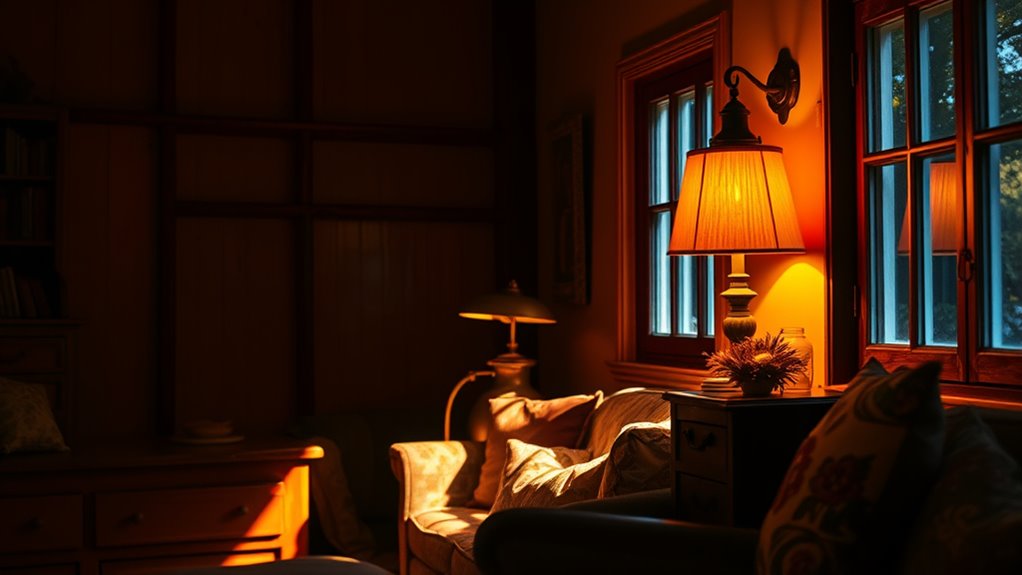The science of color temperature reveals how lighting influences your mood by impacting your brain’s emotional and alertness pathways. Warm light (2700K-3500K) creates comforting, relaxing feelings, while cooler light (5000K-6500K) boosts alertness and focus. Light spectrum, especially blue-enriched light, affects circadian rhythms and emotional regulation through neural pathways involving the limbic system. Understanding these effects helps you optimize your environment for relaxation or productivity—discover how these insights can enhance your well-being.
Key Takeaways
- Warm lighting (~2700K-3500K) promotes relaxation and comfort, positively influencing mood and reducing negative affect.
- Cooler lighting (~5000K-6500K) increases alertness and focus by mimicking natural daylight, boosting mental clarity.
- Blue-enriched light (~480 nm) affects circadian rhythms and limbic pathways, impacting mood, stress, and emotional regulation.
- Light spectrum influences neural activity, modulating hormones like melatonin and cortisol, which are linked to mental health.
- Properly designed lighting environments can enhance emotional well-being by leveraging the psychological effects of color temperature.
Understanding How Color Temperature Shapes Emotions
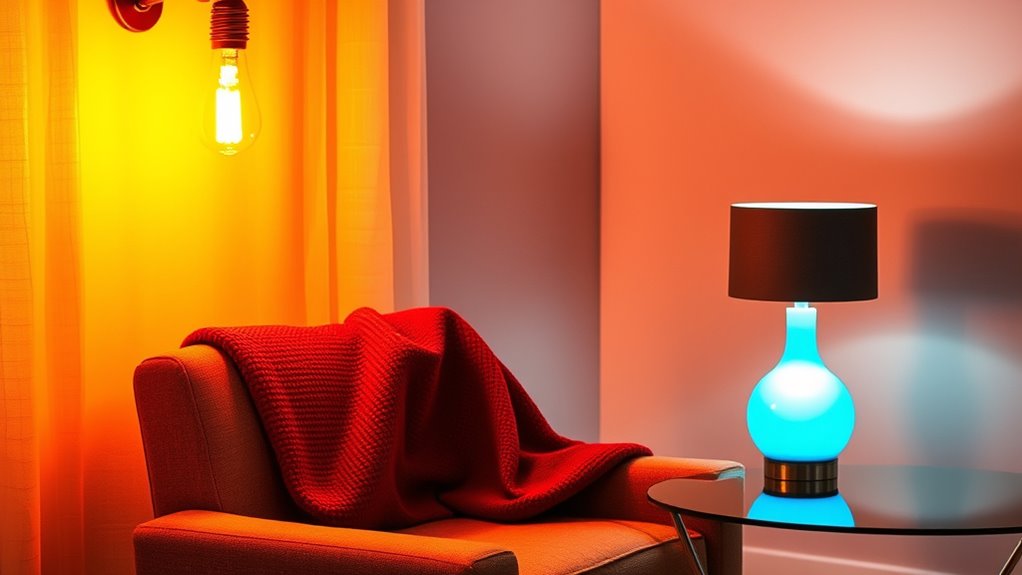
Understanding how color temperature shapes emotions is key to manipulating the mood of a space. Your choice of color temperature directly influences emotional perception, affecting how you feel in that environment. Warm lighting, with lower color temperatures between 2700K and 3500K, emits yellowish to orange hues that create a cozy, relaxing atmosphere. This lighting can reduce negative affect, helping you feel calmer and more comfortable. On the other hand, cooler color temperatures from 5000K to 6500K produce bluish-white light, which heightens alertness and focus. Proper lighting design leverages this knowledge to foster desired emotional states, whether promoting relaxation or stimulating productivity. Additionally, understanding lighting safety and regulation is important when designing environments to ensure they are both effective and safe. Recognizing color temperature’s effect on mood allows designers to select lighting that enhances emotional well-being and cognitive performance. Awareness of automation technologies in lighting systems enables the creation of dynamic environments that adapt to different needs and times of day, optimizing mood and productivity. Incorporating AI-driven lighting controls can further tailor environments to individual preferences, enhancing overall well-being and functionality. Moreover, considering natural light exposure in design can significantly improve mood and circadian rhythms, contributing to overall health. By understanding how color temperature impacts mood, you can strategically craft environments that enhance well-being and cognitive performance.
The Different Types of Lighting and Their Psychological Effects
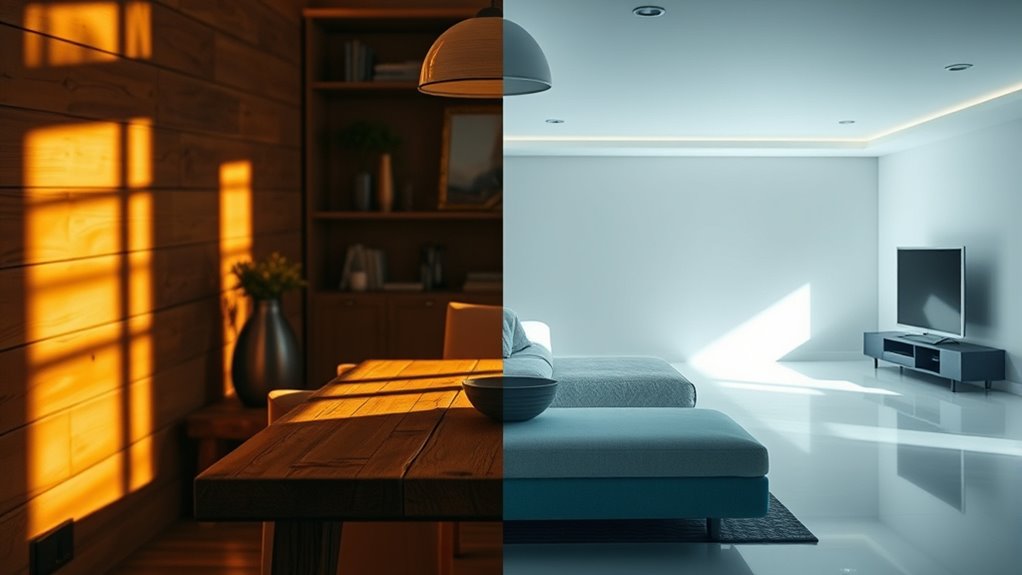
Different types of lighting, distinguished by their color temperature, have distinct psychological effects that influence your mood and behavior. Warm white lighting, around 2700K-3000K, creates cozy, relaxing atmospheres that promote comfort and contentment. Neutral white light, between 3500K-4000K, offers a balanced, natural illumination that helps you focus and suits various settings. Cool white lighting, from 5000K to 6500K, emits bright, daylight-like light that enhances alertness and is ideal for tasks requiring attention. Higher CCTs are associated with increased alertness and may even reduce feelings of depression. Different lighting sources, such as incandescent, LED, or fluorescent, impact psychological effects by varying in color temperature and spectral composition, ultimately shaping your human mood and sense of well-being. Additionally, understanding how lighting impacts mood can be an essential part of designing environments that promote emotional well-being. Recognizing the psychological effects of light spectrum can help you select the most beneficial lighting for different activities and emotional states. Research also indicates that lighting in family photoshoots can influence the overall tone and success of the session. Moreover, recent studies have shown that lighting control allows for dynamic adjustments to better suit individual emotional needs throughout the day.
How Warm and Cool Lighting Influence Mood and Well-Being
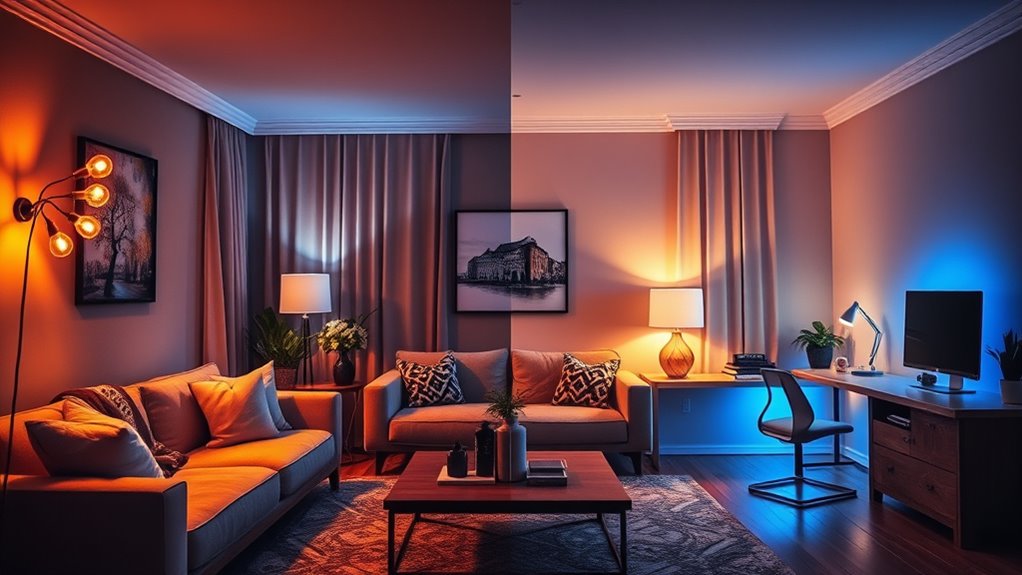
Warm lighting creates cozy spaces that help you feel relaxed and comfortable, making it ideal for unwinding. In contrast, cool lighting mimics natural daylight, boosting your alertness and focus. Choosing the right type of light can markedly influence your mood and overall well-being. Additionally, embracing minimalism in lighting design can enhance the calming effects of warm tones while maintaining a clean, uncluttered aesthetic. Incorporating natural elements such as wood accents or plants into your lighting scheme can further promote tranquility and a sense of harmony within your space. Understanding how self watering plant pots function can also contribute to a more relaxed and well-maintained environment, supporting your overall mood and health. For instance, selecting vegetable juices that support your health can complement the calming atmosphere and promote overall wellness.
Warm Light Effects
Warm light, usually between 2700K and 3000K, creates inviting environments that naturally promote relaxation and comfort. This type of warm lighting influences your mood and emotional well-being by fostering feelings of safety and intimacy. When you use warm color temperature in your space, you can experience:
- Increased feelings of contentment and reduced stress levels
- An enhanced sense of calm, making spaces more welcoming
- Improved overall well-being by decreasing negative emotions and boosting happiness
Cool Light Benefits
Cool light, typically ranging from 5000K to 6500K, closely resembles natural daylight and has a powerful impact on your mood and mental clarity. When you incorporate cool light into your space, you enhance alertness and focus, which can boost your overall emotional well-being. This type of ambient lighting activates brain regions involved in emotion processing, supporting mental stability. Studies show that exposure to cool lighting reduces feelings of depression, increases productivity, and decreases fatigue. By implementing cool light in workspaces or public areas, you foster a sense of vitality and reduce stress. This environment encourages a positive mood and sharpens mental performance, making cool light an effective tool for improving emotional health and maintaining alertness throughout your day. Additionally, understanding the lighting spectrum can help optimize the benefits of cool lighting for mental health. Incorporating creative practices such as mindful lighting design can further enhance your space’s emotional impact. Recognizing the importance of color temperature helps tailor lighting environments to support specific emotional and cognitive needs. Moreover, strong attention to testing methodologies ensures that lighting solutions are both effective and safe for users. Exploring different lighting techniques can also maximize the psychological benefits of cool light.
The Impact of Light Spectrum on Circadian Rhythms and Mental Health

The spectrum of light you’re exposed to during the day considerably influences your circadian rhythms and mental health. Higher color temperatures, like blue-enriched light (5000K-6500K), can advance your circadian phase, boosting alertness and wakefulness. Here’s how it impacts you:
- Blue light suppresses melatonin more effectively, affecting sleep onset and quality.
- Proper light spectrum tuning supports hormonal regulation, stabilizing cortisol and melatonin levels.
- Excessive exposure to high CCT lighting may increase risks of mood disorders like depression and cause circadian misalignment.
- Incorporating personal development techniques such as mindfulness and goal-setting can help mitigate the negative effects of disrupted circadian rhythms on mental health.
- Understanding the energetic alignment between light exposure and personal well-being can further enhance your mental health strategies.
Scientific Insights Into Neural Pathways Affected by Light
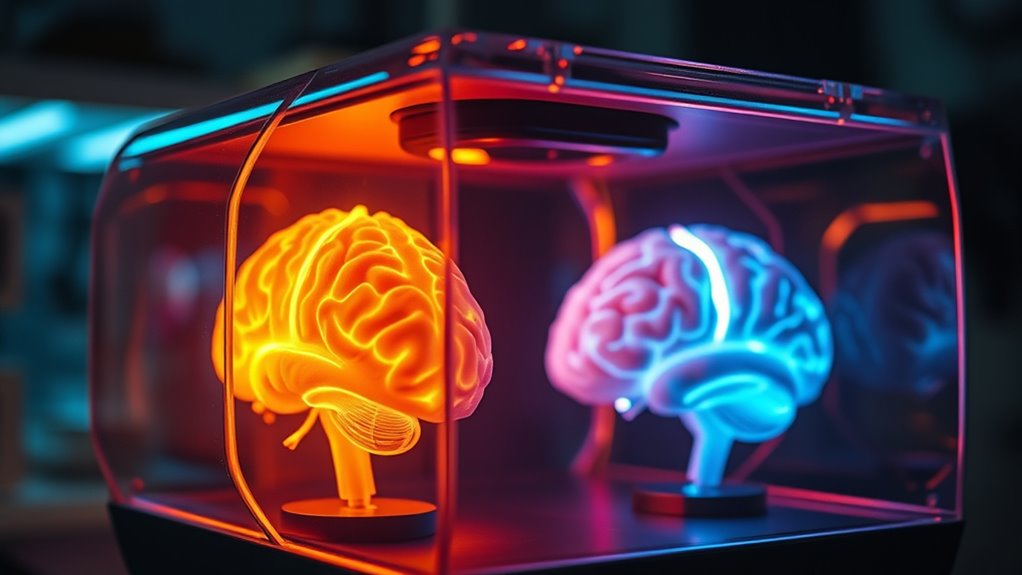
Light influences your brain’s emotional and circadian centers through specialized retinal cells called ipRGCs. These cells contain melanopsin, which makes them sensitive to blue light around 480 nm. When activated, ipRGCs send signals directly to the suprachiasmatic nucleus (SCN), regulating your circadian rhythms. They also project to limbic regions such as the amygdala and prefrontal cortex, which are involved in emotional processing. These neural pathways connect light detection to mood and stress responses via both bottom-up signals from ipRGCs and top-down pathways affecting cortical areas. Variations in light spectrum and intensity can influence activity in these pathways, impacting your emotional perception, mood, and cognitive functions linked to emotional regulation. The neural pathways affected by light shape your overall emotional and circadian health.
Practical Ways to Use Lighting to Enhance Environments
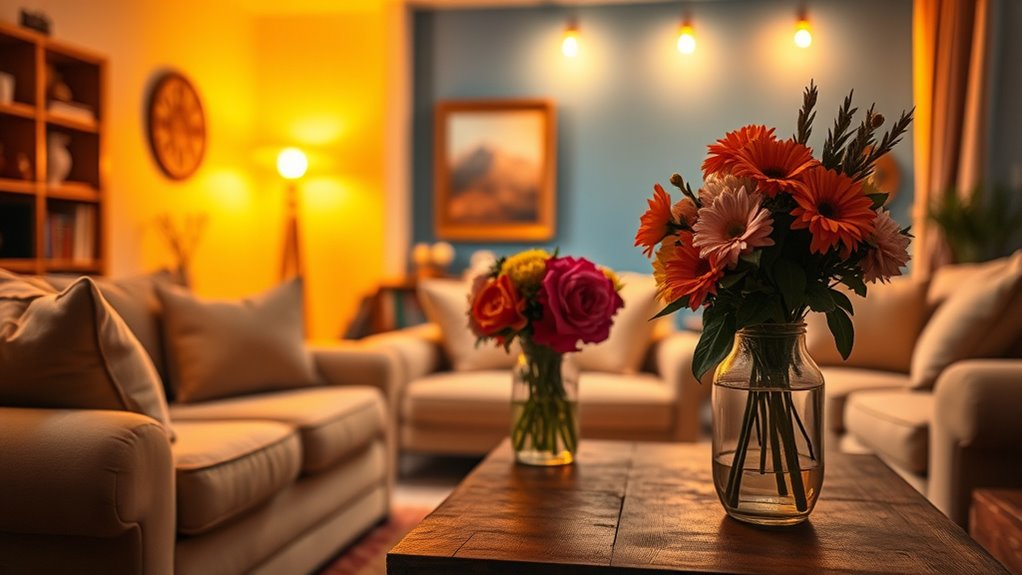
By tailoring lighting to match specific activities and environments, you can effectively influence mood and emotional well-being. Adjusting the Color Temperature (CCT) helps create the right atmosphere:
- Use warm colors (2700K-3000K) in bedrooms and restaurants to foster coziness, relaxation, and intimacy.
- Opt for neutral white lighting (3500K-4000K) in offices and retail spaces to promote focus and a natural, daylight-like glow.
- Choose cool white light (5000K-6500K) for kitchens, workspaces, and outdoor areas to boost alertness and productivity.
Strategic lighting choices can reduce negative affect and improve cognitive performance. Incorporating appropriate CCTs influences mood, making spaces more inviting and functional based on their purpose.
Future Directions in Lighting and Mood Research

As research in lighting and mood continues to advance, exploring long-term effects of various correlated color temperatures (CCT) becomes increasingly important. You’ll want to understand how different CCT levels influence mood regulation over time, especially in diverse lighting environments. Integrating neuroimaging can reveal how light spectra impact emotional processing, leading to more effective personalized lighting solutions. These can adapt CCT and illuminance to your psychological and physiological responses. Additionally, studying natural light’s interaction with artificial lighting and seasonal changes can deepen your understanding of mood regulation. Virtual reality and augmented reality tools offer promising avenues for simulating lighting environments. Here’s a glimpse into future research directions:
| Focus Area | Key Objective | Potential Impact |
|---|---|---|
| Long-term studies | Assess effects of CCT on mental health | Better lighting design |
| Neuroimaging | Uncover neural mechanisms | Targeted mood interventions |
| Personalized lighting | Tailor light based on individual responses | Optimized mood support |
Frequently Asked Questions
How Does Color Temperature Affect Mood?
You might notice that warm lighting makes you feel cozy, relaxed, and comfortable, while cooler light boosts your alertness and energy. When you’re under neutral lighting, you often feel balanced, able to focus or unwind as needed. Bright, blue-enriched light can sometimes lift your mood but may also cause fatigue if overexposed. So, your mood shifts depending on the color temperature and how you experience it in your environment.
What Is the Science of Color and Mood?
Ever wonder how colors and light influence your feelings? The science of color and mood explores this by showing how hues and spectra impact your emotions and mental state. Warm shades create comfort, while cool tones boost alertness. You can use this knowledge to craft environments that promote relaxation or focus—making your space work for your mood. Isn’t it fascinating how simple color choices can shape your emotional experience?
What Is the Science Behind Color Temperature?
You might wonder about the science behind color temperature. It’s based on how light sources emit specific wavelengths, measured in Kelvin, that influence how we perceive warmth or coolness. Lower Kelvin values produce a warm, yellowish glow, while higher values create a cool, bluish light. This variation affects your mood, alertness, and comfort by interacting with your eyes and brain’s response to different lighting conditions.
What Is the Best Color Temperature for Mental Health?
You’re asking about the best color temperature for mental health. Generally, warmer white light (2700K-3000K) helps you relax and feel comfortable, which supports mental well-being. Neutral white (3500K-4000K) strikes a balance, aiding focus without overstimulation. Cooler white light (5000K-6500K) boosts alertness during the day but can cause discomfort if overused. Choose warmer tones for relaxation and cooler ones for activity to optimize your mood.
How Does Color Temperature Affect Humans?
Color temperature influences how you feel and function daily. When you’re exposed to warm light around 2700K, you tend to feel more relaxed and cozy. Cooler light, between 5000K and 6500K, boosts alertness and concentration. During the day, blue-enriched lighting can lift your mood and enhance focus. So, adjusting your lighting can help you feel calmer or more alert, depending on your needs.
Conclusion
Now that you understand how color temperature influences emotions, you realize it’s not just about brightness but the mood you create. Warm lighting feels cozy, yet cool light energizes, highlighting the power of perception. As science uncovers neural pathways and circadian effects, you see that lighting shapes your well-being just as much as your environment. Embrace this knowledge—your choices in light can transform your space, mood, and health in ways you never imagined.
